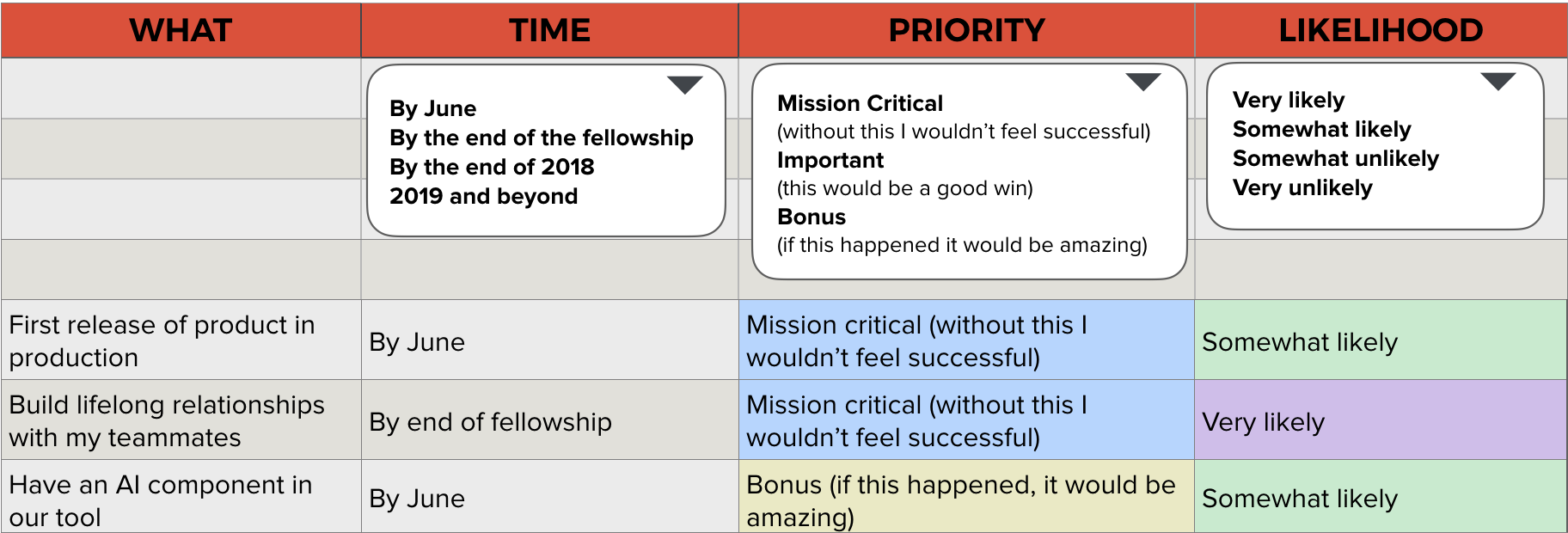Are you successful? How do you know?
If you want to run a high-performing team, it’s critical to know what success means to the team as a whole and to each member. You can find out in a direction-setting exercise so you’re sure everyone’s working toward the same goals and objectives. I recently helped Code for Canada’s fellows and project teams define success and prioritize their objectives. Use our framework to define and achieve success in your own work.
Digital government, radical change
It’s no secret that there’s a digital revolution happening within government. Departments everywhere are shouting from the rooftops about:
- Challenging the status quo
- Putting user needs first
- Removing barriers to accessing government services
- Partnering outside of government
It’s such a welcome move. If you love user-centred design like I do, you were likely impressed by how the UK revamped service delivery for citizens with its Government Digital Service several years ago. In Canada, we’re rapidly catching up.
Ontario named its first Chief Digital Officer in 2017, and federally, the Canadian Digital Service was born. Other federal departments have undertaken their own modernization initiatives like Innovation, Science and Economic Development Canada’s Innovation Lab. As the Government of Canada’s CIO says, “there’s no better time to be in public sector tech.”
Code for Canada’s role
Code for Canada is part of this renaissance. They improve how governments deliver services to Canadians by linking government departments with design and technology specialists. Their fellowship program embeds digital professionals inside government departments to work on critical projects that could benefit from outside knowledge, perspectives, and skills.
The first cohort of fellows has already been assigned to projects — one group is with Ontario’s Ministry of Advanced Education and Skills Development, and another is with the federal Treasury Board Secretariat. Each cross-functional team incorporates product and project management, user experience design and development, and other important skills into their projects. These edgewalkers are shaking up deep-rooted systems and moving us all toward more citizen-centred design.
Where are the goal posts?
Knowing your end goal is always important, and arguably more so when you’re working on something new and complex. Luckily, Code for Canada’s people are dialed into the importance of identifying and continuously managing what success looks like for their own organization, their fellows, and their government partners.
I met Code for Canada’s Fellowship Program Manager, Lia Milito, in February when she asked me to work with her to design a fellows’ retreat. Since the first group of fellows were part way through their projects, we wanted to bring everyone together to ensure they were on track to achieve success. We knew that if stakeholders’ visions and desired outcomes were similar, it would be smooth sailing, but that mismatched expectations could cause tensions that would limit each project’s potential. That’s why it was important to make time to explore each person’s and group’s distinct needs.
I designed a framework to help us discuss success during the full-day retreat in early March. As it turned out, our approach was highly successful and entirely replicable, so I want to share it with you.
The framework
Chances are, you go to work at the same organization each day, have reasons for working there, and have thought about the goals you hope to achieve. The organization also has its own targets, and you may have clients or partners with specific ideas about what they need to accomplish. This is a complex web, and managing all the expectations is critical. In fact, I’d say that being able to express, understand, and manage expectations is essential to happiness and success. (True in life, true in work.) My framework will help you sort through this web by answering three initial questions so you can address any barriers to success:
- What are each stakeholder’s objectives and priorities?
- What is the likelihood that each stakeholder can achieve their objectives?
- Where are their objectives or priorities at odds?
Step One
Create a success matrix (i.e., a spreadsheet) that names what success looks like for each stakeholder group. Give each of them their own column. For example, if you work in a university department you might have: faculty, graduate students, and funders.
In Code for Canada’s case, we were interested in clarifying what success meant for three groups: Code for Canada, government partners, and fellows. Here’s what the top of our spreadsheet looked like:
Tip: At our retreat, we used Google spreadsheets as virtual whiteboards to create success matrices. We exposed considerations and focused our conversations, all while contributing and collaborating in real time. You can use this approach too.
As soon as you start adding content to the matrix, you’ll begin to notice patterns, commonalities, and areas of divergence. That’s when you can begin to ask each other more detailed questions:
- What assumptions are we making?
- Is there anything here we didn’t know before?
- Is there anything here that surprises us?
- What do the stakeholders have in common? What’s different?
- What’s particularly interesting about what we’ve uncovered?
- Is there anything we need to do or change going forward based on what we see?
The most meaningful part of the exercise is working through expectations that are different or at odds. In these cases, you’ll want to ask a few more questions:
- How might we reconcile these differences?
- Is one stakeholder group (and their objectives) more important than the other?
- Are everyone’s expectations realistic and attainable? If not, how can we manage them?
Step Two
Push your success matrix further by adding criteria that identify what is important as well as its priority, the timing, and the likelihood you can achieve it.
During our retreat, each Code for Canada fellow completed an Individual Success Matrix, and each project team completed a Team Success Matrix. You can see an example matrix below.
The matrix is made up of a few columns. The “what” column describes what the individual or group wants to achieve (i.e., success) and the subsequent columns contain a drop-down menu of options. When you build your own matrix, customize the ‘what’ and the drop-down menus to suit your needs.
Once your spreadsheet is complete, you can sort it in different ways. Code for Canada was particularly interested in items deemed “mission critical” and “very unlikely”. When these turned up, we talked about how we could move them into the “likely” category. We talked about whether the expectation was realistic, and whether other factors could be dialed up or down to improve the likelihood that the team or person could achieve success within the desired timeframe.
Watching the project teams complete their success matrix was probably the most exciting part of the day. Each team used their time wisely and had meaningful conversations about what their priorities should be and what needed to happen to improve the likelihood they would achieve their desired results.
It’s astounding how useful and motivating these exercises are for project teams. Imagine having a centralized place where the way everyone defines success is documented and prioritized! As the project evolves, the spreadsheet can act as a tool for facilitating difficult conversations and making adjustments so that as many people as possible (hopefully everyone) will be happy with the final outcomes.
Where we landed
The participants agreed unanimously that the Code for Canada retreat came at a critical time and that it was incredibly useful. The fellows liked being forced to prioritize their hopes and activities, which, if left undefined, would be overwhelming and stressful. The project teams were relieved to have the dedicated time they needed to set priorities and call out the potential barriers to achieving their success. One team was able to prioritize what should be included in its product roadmap, and the other team came to a clear consensus about its mission critical items. Everyone had valuable conversations about how to make “unlikely” items “somewhat or “very likely”.
Code for Canada will continue to use the framework we created as a way to talk about and evaluate success for the remainder of this fellowship cohort, and beyond.
Go ahead, try it
It’s amazing how individuals, groups, and organizations can benefit from a simple tool that defines success and names challenges out in the open. Since the commonalities and differences among individual, group, and organizational desires can be an intertwined web, exercises like this help us see and manage tensions where they exist. It’s cost-effective and takes less time than you’d expect (far less time than botching a project and scrambling to get it back on track!). Still, it’s woefully rare that teams undertake projects with clear success statements in constant view.
The next time you start a project, consider tracking stakeholders’ expectations in a success matrix and checking in regularly as the project evolves. You’ll be surprised by how well this can help guide you to great results.
Tell me how this works for you! If you need help defining and enabling success inside your organization, let’s talk. There’s nothing I love more than helping individuals and organizations reach their maximum potential.


